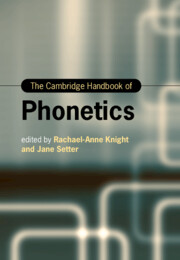Book contents
- The Cambridge Handbook of Phonetics
- Cambridge Handbooks in Language and Linguistics
- The Cambridge Handbook of Phonetics
- Copyright page
- Contents
- Figures
- Tables
- Contributors
- Introduction
- Section I Segmental Production
- Section II Prosodic Production
- Section III Measuring Speech
- 10 Measuring Vowels
- 11 Measuring Consonants
- 12 Measuring Speech Rhythm
- 13 Fundamental Frequency and Pitch
- 14 Observing and Measuring Speech Articulation
- 15 Beyond Functional Speech Synthesis
- Section IV Audition and Perception
- Section V Applications of Phonetics
- Index
- References
10 - Measuring Vowels
from Section III - Measuring Speech
Published online by Cambridge University Press: 11 November 2021
- The Cambridge Handbook of Phonetics
- Cambridge Handbooks in Language and Linguistics
- The Cambridge Handbook of Phonetics
- Copyright page
- Contents
- Figures
- Tables
- Contributors
- Introduction
- Section I Segmental Production
- Section II Prosodic Production
- Section III Measuring Speech
- 10 Measuring Vowels
- 11 Measuring Consonants
- 12 Measuring Speech Rhythm
- 13 Fundamental Frequency and Pitch
- 14 Observing and Measuring Speech Articulation
- 15 Beyond Functional Speech Synthesis
- Section IV Audition and Perception
- Section V Applications of Phonetics
- Index
- References
Summary
This chapter provides an introduction to the acoustic and perceptual measurement of vowels. The measurable acoustic properties of vowels are formants, duration, pitch and intensity. Perceptual measurements include identification and discrimination of natural or synthesised vowels. After a brief review of the historical representation of the vowel space, technical details are given on measuring the acoustic properties of vowels, including perceptual measurements and speaker normalisation. This last plays a pivotal role in vowel space comparison among various language and gender groups. A few normalisation methods, along with the transformation of acoustic formant frequency values into auditory scales, are reviewed to provide a foundation for a cross-linguistic and curvilinear comparison of vowels. In addition, we describe competing models and theories and discuss correlations between vowel height and pitch, followed by practical scenarios and future studies on these measurements using software and internet resources.
Keywords
- Type
- Chapter
- Information
- The Cambridge Handbook of Phonetics , pp. 261 - 284Publisher: Cambridge University PressPrint publication year: 2021
References
10.7 References
- 2
- Cited by

